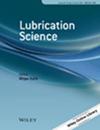Lubrication Performance and Wear Mechanism of Double-Circular-Arc Spiral Bevel Gears for Nutation Drive in Mixed Lubrication
Abstract
A thermal elastohydrodynamic lubrication model is combined with a wear model under mixed lubrication to investigate the lubrication performance and wear characteristics of double-circular-arc spiral bevel gears for nutation drive. Moreover, the effects of operating conditions on the characteristic parameters of the film are analysed under the mixed lubrication point-contact conditions. Furthermore, the characteristics of gears in terms of friction coefficient and wear depth are discussed. According to the results, the performance of lubrication and wear during the mutual meshing of the convex tooth surface of the external bevel gear and the concave tooth surface of the inner bevel gear is better than that during the mutual meshing of the other pair of tooth surfaces. The minimum film thickness of the whole meshing process occurs near the inner of the bevel gear due to the joint action of the load and the end edge effect. Moreover, an increase in torque at a certain rotational speed is favourable to the lubrication performance of the meshing process. The wear depth in the double-circular-arc spiral bevel gears' meshing process is heavily influenced by the roughness of the tooth surface.

 求助内容:
求助内容: 应助结果提醒方式:
应助结果提醒方式:


